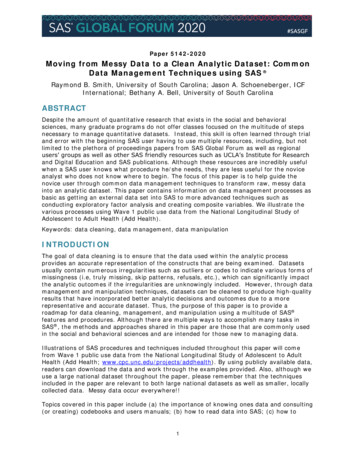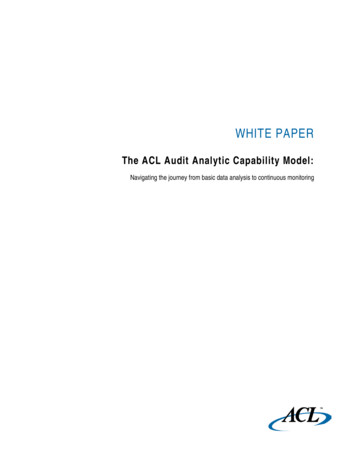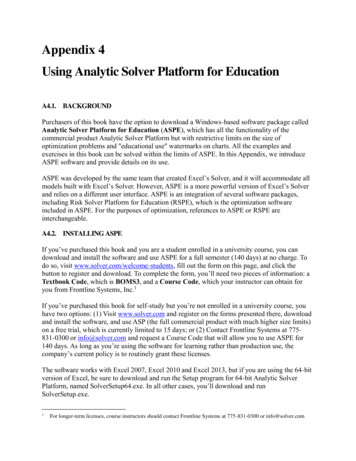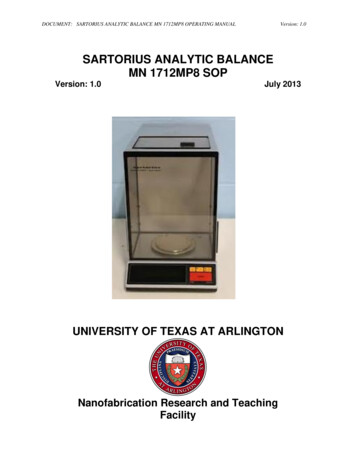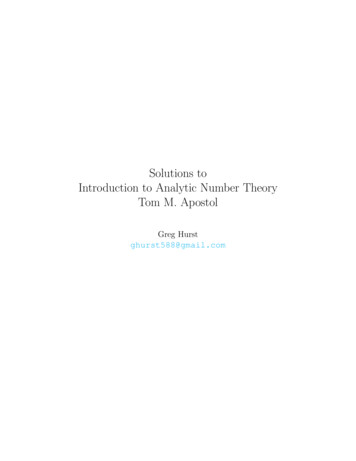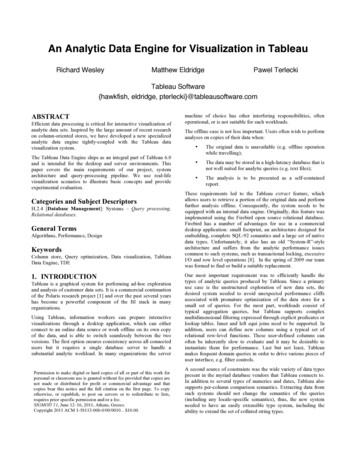
Transcription
An Analytic Data Engine for Visualization in TableauRichard WesleyMatthew EldridgePawel TerleckiTableau Software{hawkfish, eldridge, pterlecki}@tableausoftware.comABSTRACTEfficient data processing is critical for interactive visualization ofanalytic data sets. Inspired by the large amount of recent researchon column-oriented stores, we have developed a new specializedanalytic data engine tightly-coupled with the Tableau datavisualization system.The Tableau Data Engine ships as an integral part of Tableau 6.0and is intended for the desktop and server environments. Thispaper covers the main requirements of our project, systemarchitecture and query-processing pipeline. We use real-lifevisualization scenarios to illustrate basic concepts and provideexperimental evaluation.Categories and Subject DescriptorsH.2.4 [Database Management]: Systems – Query processing,Relational databases.General TermsAlgorithms, Performance, DesignKeywordsColumn store, Query optimization, Data visualization, TableauData Engine, TDE1. INTRODUCTIONTableau is a graphical system for performing ad-hoc explorationand analysis of customer data sets. It is a commercial continuationof the Polaris research project [1] and over the past several yearshas become a powerful component of the BI stack in manyorganizations.Using Tableau, information workers can prepare interactivevisualizations through a desktop application, which can eitherconnect to an online data source or work offline on its own copyof the data, and is able to switch seamlessly between the twoversions. The first option ensures consistency across all connectedusers but it requires a single database server to handle asubstantial analytic workload. In many organizations the serverPermission to make digital or hard copies of all or part of this work forpersonal or classroom use is granted without fee provided that copies arenot made or distributed for profit or commercial advantage and thatcopies bear this notice and the full citation on the first page. To copyotherwise, or republish, to post on servers or to redistribute to lists,requires prior specific permission and/or a fee.SIGMOD’11, June 12–16, 2011, Athens, Greece.Copyright 2011 ACM 1-58113-000-0/00/0010 10.00.machine of choice has other interfering responsibilities, oftenoperational, or is not suitable for such workloads.The offline case is not less important. Users often wish to performanalyses on copies of their data when: The original data is unavailable (e.g. offline operationwhile travelling); The data may be stored in a high-latency database that isnot well suited for analytic queries (e.g. text files); The analysis is to be presented as a self-containedreport.These requirements led to the Tableau extract feature, whichallows users to retrieve a portion of the original data and performfurther analysis offline. Consequently, the system needs to beequipped with an internal data engine. Originally, this feature wasimplemented using the Firebird open source relational database.Firebird has a number of advantages for use in a commercialdesktop application: small footprint, an architecture designed forembedding, complete SQL-92 semantics and a large set of nativedata types. Unfortunately, it also has an old “System-R”-stylearchitecture and suffers from the analytic performance issuescommon to such systems, such as transactional locking, excessiveI/O and row level operations [8]. In the spring of 2009 our teamwas formed to find or build a suitable replacement.Our most important requirement was to efficiently handle thetypes of analytic queries produced by Tableau. Since a primaryuse case is the unstructured exploration of new data sets, thedesired system needed to avoid unexpected performance cliffsassociated with premature optimization of the data store for asmall set of queries. For the most part, workloads consist oftypical aggregation queries, but Tableau supports complexmultidimensional filtering expressed through explicit predicates orlookup tables. Inner and left equi joins need to be supported. Inaddition, users can define new columns using a typical set ofrelational row-level functions. These user-defined columns canoften be inherently slow to evaluate and it may be desirable toinstantiate them for performance. Last but not least, Tableaumakes frequent domain queries in order to drive various pieces ofuser interface, e.g. filter controls.A second source of constraints was the wide variety of data typespresent in the myriad database vendors that Tableau connects to.In addition to several types of numerics and dates, Tableau alsosupports per-column comparison semantics. Extracting data fromsuch systems should not change the semantics of the queries(including any locale-specific semantics), thus, the new systemneeded to have an easily extensible type system, including theability to extend the set of collated string types.
Another design constraint came from the target platform forTableau Desktop. A significant fraction of the target audiencewas presumed to be working on 32-bit Windows laptops with2-4GB of RAM. These same users were also expected to beworking with data sets that might exceed their working memory,thus, a non-memory-resident system was required that couldperform well on this limited hardware configuration.Moreover, the desktop application is mostly delivered viadownloads from the Internet, which meant that the new systemneeded to have a relatively small execution image (Firebird’sdownload footprint was on the order of 1.5MB).The Tableau system is also provided in a server configuration forcollaborative sharing of visualizations. The server operatingsystem was intended to be 64-bit Windows to support largeraddressable memory. Existing Tableau server deploymentsrequire only a fraction of available storage of a single machine.Under this simplifying assumption, we expected the database toscale-up and scale-out.In addition, there was also a set of “non-requirements”. Mostnotably, the system did not need to have any sort of single rowupdate capability because Tableau does not perform such “writeback” operations. Tableau also presumes that integrity constraintsare to be enforced by the source database itself. Stored proceduresare not used.As in our solution, compressed data is kept in a workbook.However, data processing capabilities in Gemini are currentlylimited by the available memory. Slow calculations can bepersisted as columns on-demand, which is similar to extractoptimization in Tableau (see Sect. 5.1).Section 2 provides a running visualization example. The TDEarchitecture is covered in Sect. 3. Data compression and queryoptimization are given in Sect. 4 and 5, respectively. Section 6presents experiments. We describe additional visualizationsupport, such as query cancellation, in Sect. 7. The paper isconcluded in Sect. 8.2. Visualization ScenarioTableau provides a drag and drop interface for interactive dataexploration. It uses the VizQL language [1] to describe ananalytical query and associated graphical layout. Queries arecaused by user interactions and consequently have an ad hocnature. The results received from the database are further postprocessed and rendered to obtain a specified visualization.After reviewing the available systems (both commercial and opensource) we concluded that there was no existing system that couldmeet our needs: Complex filters are often best expressed using left joinsto temporary tables and many systems have troubleexecuting such joins quickly (or at all in some cases); Typical analytic systems (and even some major “mixedworkload” vendors) do not support column-levelcollation; Most existing systems are designed for serverenvironments where hardware can be chosen to matchthe workload; Installation footprints are often quite large and nottypically designed for embedding.Accordingly, we set out to build our own analytic query engine.A review of the literature led us to a block-iterated column storedesign modeled on the MonetDB/X100 project [2] and subsequentwork. Our new specialized data engine is further referred to asTableau Data Engine (TDE). It can be configured to operate ineither a single user desktop application environment or a sharedserver environment. The latter uses a shared-nothing architecturewith inter-query parallelism. The focus of this paper is efficientdata processing support for Tableau Desktop.As mentioned before, our project was strongly influenced by theextensive research around MonetDB [2][3]. We also includedsome concepts on operations on compressed data from C-Store[4]. In addition, we investigated other commercial column stores.In particular, InfoBright [11] partitions its data into 64KBportions, called data packs. Rich statistical information associatedwith each pack enables a quick exclusion of data that areirrelevant for a given query. The Gemini add-on to MicrosoftExcel is an embedded database with a column-oriented storage.Figure 1. Visualization of profit and sales correlation overtime for different regions and products.Let us consider a simple data relation with two measures Salesand Profit, and four dimensions: Time, State, Product andSupplier. We want to investigate the correlation of both measuresover time for each Product and State. This can be accomplishedby a tabular view where each column corresponds to a differentProduct and each row to a different State. Each cell of the gridcontains the corresponding correlation chart (Fig. 1).In order to make the visualization less detailed one may want toroll up on Time and State. Since no explicit hierarchies aredefined on those dimensions, we define new higher dimensionlevels using auxiliary functions:
Year year func(Time) {2000,.,2010}, defined as a4-character prefix of Time; the latter is assumed to beencoded as a string; Region region func(State) {NORTH, WEST,SOUTH, EAST}, which is a manually-providedpartition of State and can be expressed as a CASEWHEN statement with equality conditions.Tableau uses an abstract query representation to perform initialtransformations and optimizations. Depending on the type of atarget data source, an appropriate database query is generated.Assuming that the data are stored in a denormalized relationaltable T, both measures and dimensions map to its columns. Also,the new dimension levels can be expressed as computed columnsin the table’s schema. The required data can be retrieved by thefollowing SQL query:SELECTSUM(Profit), SUM(Sales),Product, Region, YearFROMTGROUP BYProduct, Region, YearNote that the data is already grouped to simplify the additionalpost-processing on the client.We continue this example with respect to query processing in thedata engine presented below.3. SYSTEM OVERVIEWFor the purposes of exposition, it is convenient to view theTableau Data Engine (TDE) as being comprised of several layers: A storage model; An execution engine; A query parser and optimizer; A communication interface; The Tableau VizQL compiler.This section will give a brief description of each of these pieces;later sections will focus on the details of the compiler andexecution engine.3.1 Storage ModelThe TDE has a typical three-level logical object namespace ofschemas, tables and columns. For simplicity, this namespace isstored as a multi-level “directory” structure. Each table is then adirectory that contains column files, each schema is a directorycontaining tables and a database is a top-level directory containingthe schemas.For most tables and columns, metadata is stored in special tablesin the reserved SYS schema. Metadata in the SYS schema (andother special schemas like TEMP) is kept in yaml key-value filesnext to the column, one metadata file per object (column, table,schema). Object names can then be decoupled from theunderlying file structure.Column files are of two kinds: a fixed width array of values andan optional “dictionary” file. When a dictionary is present, thevalue array contains dictionary tokens instead of actual values.The “directory” structure is abstracted to enable implementationsother than the simple file system version described above. Themost important implementation is a read-only implementation thatpackages a database as a single file for user convenience3.2 Execution EngineThe TDE execution engine follows traditional database patterns. Itsupports a collection of operators and function primitives. Eachoperator implements a certain data processing algorithm andconsumes rows on its optional inputs to produce output rows. Aquery plan is a tree of operators. It is executed by iterating over allthe rows of the root of the tree. For the sake of performance, weemploy block processing with a fixed block size and optionalselection vector to mark valid rows [2].The parser generates query operators, which come in two basicflavors: streaming (Data Flow) and stop-and-go (Table). The firstones can process input blocks independently, e.g. a projection thatsimply defines new columns in a block. On the other hand, stopand-go operators need to consume all the input rows andmaterialize the intermediate result before any rows can be output.An aggregation of unordered data is an example.In addition to the query operators, there are a number of commandoperators that implement DDL statements and miscellaneousserver operations unrelated to query processing.3.3 Query Parser and OptimizerTableau performs an initial analysis of a query to apply generaloptimizations valid across many target data sources (see Sect. 5).Inferences are made using an abstract tree representation of aquery. We based our approach on selected concepts from therelational algebra.Most engines use declarative languages and require appropriatetranslation of the internal query representation. To make similartranslations straightforward on both ends of the wire for the TDE,we developed a Tableau Query Language (TQL). It preserves thesemantics and tree structure of an abstract query built on theTableau side.The query parser accepts text commands in TQL and convertsthem into an in-memory tree representation. The initial treefurther transformed by the optimizer and converted to anexecutable query plan.3.4 Communication InterfaceThe Tableau Data Engine runs as a separate processcommunicating over standard sockets. The TDE side of theprotocol just reads queries and other commands from the channeland routes them to a multi-threaded session manager. The resultsof the commands are then written to the channel.In addition to the main communication channel, sessions can beaddressed through a secondary control channel. This channelsupports user interaction with running queries by reportingprogress and allowing the user to cancel long-running queries in aresponsive manner.Tableau has an internal API that can be used to send and receivequeries from a wide variety of data providers. In addition to astandard OLE DB/ODBC wrapper, the API can be used to wrapnative implementations, such as the InterBase API used byFirebird. For the TDE we wrote another implementation of thisAPI, which translates the operations into wire commands. Theimplementation also connects query execution to the userinterface to support progress feedback and query cancellation.
3.5 VizQL CompilerVisualizations in Tableau are expressed via the VizQLspecification language [1]. The VizQL compiler is a Tableausubsystem that accepts visualization specifications and generatesrelevant database queries for target languages, such as MDX andSQL. The existing Tableau SQL compiler was generalized tosupport TQL as a new relational dialect.4. COMPRESSIONOne of the most important benefits of a column store is the abilityto compress data and then operate on the data in its compressedform [7]. Operations on compressed data can improve theperformance of a typical analytic query by a factor of two [4]. TheTDE implements two compression strategies: dictionarycompression and run-length encoding. Dictionary compression isvisible in query processing, while the storage engine performsRLE implicitly.4.1 TokensColumns are simply arrays of a fixed width type. Their content isaccessed through a data stream interface that allows processingdata in portions fitting in memory. Most scalars (such as integers,doubles and dates) can be directly expressed in this array format.Such columns are referred to as uncompressed.Compressed columns come in two forms. Heap compression isused for variable width types such as strings and arraycompression is used for fixed width types such as dates. The dataportion of the column consists of dictionary tokens that referencemembers of the dictionary.Because the data stream of a column is required to be an array,variable width types can only be stored in heap-compressedcolumns. Under heap compression, the tokens are offsets into thedictionary and the data is stored in the form length data .The set of offset is not dense, but they simplify the system byeliminating an index-to-offset indirection.Fixed width types may also be compressed using arraycompression. In this format, the dictionary is an array of valuesand the tokens are indexes into this array. The set of array tokensis dense, which is a useful property for some operations. Arraycompressed columns can take up significantly less space thantheir uncompressed equivalent: for example, the TPC-H lineitemtable has a date column that has only about 2500 distinct values.The TDE’s date type is 4 bytes wide, but by compressing thecolumn it can be represented by 2 byte tokens, saving 50% on thestorage requirements.Tokens are just integers, so they can be compared as integers. Ifthe dictionary entries are all unique then the tokens are said to bedistinct. Distinct tokens can be compared for equality and hashedconsistently without consulting the dictionary. If the dictionary isalso sorted, then the tokens are said to be comparable.Comparable tokens can be used for sorting and orderedcomparisons.Because the TDE works on fixed data sets, tables can bemaximally compressed without having to declare the token widthahead of time – or even whether compression is wanted (e.g.columns declared enum in [3]). In addition to relieving thedesktop user from the burden of being a DBA, this kind ofmaximal compression improves memory bandwidth and createsopportunities for better hashing.4.2 Domain TablesThe relationship between a compressed column and its dictionaryresembles foreign/primary key relationship, and this observationis central to how the TDE handles compression. Decompressionis expressed in queries as a join between the main table’s tokensand a virtual domain table representing the column’s datadictionary. One interesting aspect of this approach is that it makesdecompression a high level operation, which can be reasonedabout in a natural way by the query optimizerThe TDE query optimizer can reorder predicates andcomputations across joins, reducing the amount of computationperformed. For computations and predicates that only reference acompressed column, this means that computations can beperformed on the column’s domain instead of on every row of thetable. For example, a computation to extract the year of a date inthe lineitem table can be pushed down to the 2500 date values inthe domain table and only executed that many times. A filter onthat year can also be applied before the join, further reducing thesize of the join hash table.4.3 Invisible JoinsMany predicates used in analytic queries consist of simple filterscomparing a data value to a compile time constant. In the casewhere the column is compressed, we made use of the “invisiblejoin” technique of Abadi et al. [4] to compare tokens instead ofvalues. This necessitates translation of constants to the domain ofthe column to which they are being compared.To enable this translation, TQL compiler makes a pass over theexpression tree and attempts to attach a domain name to eachconstant. When the constant node is evaluated for the first time,the
analytic data engine tightly-coupled with the Tableau data visualization system. The Tableau Data Engine ships as an integral part of Tableau 6.0 and is intended for the desktop and server environments. This paper covers the main requirements of our project,

